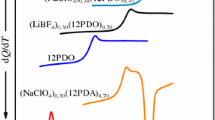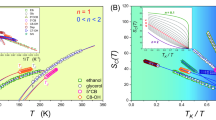Abstract
Differential scanning calorimetry (DSC) revealed an anti-sigmoidal composition dependence of the glass transition temperature in a binary mixture of dicyclohexylmethanol [\((\hbox {C}_6\hbox {H}_{11})_2\hbox {CHOH}\), DCHM] and tricyclohexylmethanol [\((\hbox {C}_6\hbox {H}_{11})_3\hbox {COH}\), TCHM]. The equimolar mixture, of which state was suggested to be robust by the dependence, was subjected to adiabatic calorimetry. The glass transition occurred around 257 K with a significant enthalpy relaxation. The excess heat capacity beyond the weighted average of heat capacities of neat compounds changes its sign from positive to negative upon the glass transition on cooling. The negative excess implies a denser molecular packing than neat glasses. The excess enthalpy is graphically given relative to \(T=298.15\) K.







Similar content being viewed by others
Data Availability
Numerical data of excess heat capacities and integrated excess enthalpy are available on request to a corresponding author.
References
Angell, C.A.: Formation of glasses from liquids and biopolymers. Science 267, 1924–1935 (1995)
Debenedetti, P.G., Stillinger, F.H.: Supercooled liquids and the glass transition. Nature 410, 259–267 (2001)
Berthier, L., Biroli, G.: Theoretical perspective on the glass transition and amorphous materials. Rev. Mod. Phys. 83, 587–645 (2011)
Parisi, G., Urbani, P., Zamponi, F.: Theory of Simple Glasses: Exact Solutions in Infinite Dimensions. Cambridge University Press, Cambridge (2020)
Kauzmann, W.: The nature of the glassy state and the behavior of liquids at low temperatures. Chem. Rev. 43, 219–256 (1948)
Angell, C.A., Sare, E.J.: Glass-forming composition regions and glass transition temperatures for aqueous electrolyte solutions. J. Chem. Phys. 52, 1058–1068 (1970)
Angell, C.A., Sare, J.M., Sare, E.J.: Glass transition temperatures for simple molecular liquids and their binary solutions. J. Phys. Chem. 82, 2622–2629 (1978)
Angell, C.A., Sare, E.J., Donnella, J., MacFarlane, D.R.: Homogeneous nucleation and glass transition temperatures in solutions of Li salts in \({\rm D}_2{{\rm O}}\) and \({\rm H}_2{{\rm O}}\). Doubly unstable glass regions. J. Phys. Chem. 85, 1461–1466 (1981)
Lin, A.A., Kwei, T.W., Reiser, A.: On the physical meaning of the Kwei equation for the glass transition temperature of polymer blends. Macromolecules 22, 4112–4119 (1989)
Gordon, M., Taylor, J.: Ideal copolymers and the second-order transitions of synthetic rubbers. I. Non-crystalline copolymers. J. Appl. Chem. 2, 493–500 (1952)
Couchman, P.R., Karasz, F.E.: A classical thermodynamic discussion of the effect of composition on glass-transition temperatures. Macromolecules 11, 117–119 (1978)
Kwei, T.: The effect of hydrogen bonding on the glass transition temperatures of polymer mixtures. J. Polym. Sci. 22, 307–313 (1984)
Pinal, R.: Entropy of mixing and the glass transition of amorphous mixtures. Entropy 10, 207–223 (2008)
Grolier, J.P.E., Benson, G.C.: Thermodynamic properties of binary mixtures containing ketones. VIII. Heat capacities and volumes of some n-alkanone + n-alkane mixtures at 29815 K. Can. J. Chem. 62, 949–953 (1984)
Wilhelm, E., Grolier, J.-P.: Heat capacities and related properties of liquid mixtures, solutions and vapours. In: Wilhelm, E., Letcher, T. (eds.) Heat Capacities: Liquids. The Royal Society of Chemistry, Cambridge (2010)
Suzuki, Y., Yamamura, Y., Sumita, M., Yasuzuka, S., Saito, K.: Neat liquid consisting of hydrogen-bonded tetramers: dicyclohexylmethanol. J. Phys. Chem. B 113, 10077–10080 (2009)
Yamamura, Y., Suzuki, Y., Sumita, M., Saito, K.: Calorimetric study of glass transition in molecular liquids consisting of globular associates: dicyclorohexylmethanol and tricyclohexylmethanol. J. Phys. Chem. B 116, 3938–3943 (2012)
Nagatomo, S., Nobuhira, M., Yamamura, Y., Sumita, M., Saito, K.: Identification of hydrogen-bonded oligomers in associating liquid by \(^1\)H-NMR: 1-phenyl-1-cyclohexanol. Bull. Chem. Soc. Jpn. 86, 569–576 (2013)
Sgarabotto, P., Ugozzoli, F., Sorriso, S., Malarski, Z.: Structural investigation of highly hindered methanol derivatives. 1. The structure of \(\alpha\)-cyclohexylcyclohexanemethanol. Acta Crystallogr. Sect. C 44, 671–673 (1988)
Sgarabotto, P., Ugozzoli, F., Sorriso, S., Malarski, Z.: Structural investigation of highly hindered methanol derivatives. 2. The structure of \(\alpha ,\alpha\)-dicyclohexylcyclohexanemethanol. Acta Crystallogr. Sect. C 44, 674–676 (1988)
Yamamura, Y., Saitoh, H., Sumita, M., Saito, K.: One-dimensional correlation in the dipolar Ising crystal tricyclohexylmethanol: crystal structure revisited and heat capacity. J. Phys. Cond. Matter 19, 176219 (2007)
Malarski, Z., Szostak, R., Sorriso, S.: Infra-red and Raman investigations on the multimeric structure of \(\alpha,\alpha\)-dicyclohexyl-cyclohexanemethanol. Lett. Nuovo Cimento 40, 261–264 (1984)
Saito, K., Hishida, M., Koike, K., Nagatomo, S., Yamamura, Y.: X-ray study of molecular association in alcohols having bulky substituents. Chem. Phys. Lett. 673, 74–77 (2017)
Yamamura, Y., Saito, K., Saitoh, H., Matsuyama, H., Kikuchi, K., Ikemoto, I.: Heat capacity measurements and phase transition of crystalline 4,4″-difluoro-p-terphenyl. J. Phys. Chem. Solids 56, 107–115 (1995)
Preston-Thomas, H.: The international temperature scale of 1990 (ITS-90). Metrologia 27, 3–10 (1990)
Suga, H., Seki, S.: Thermodynamic investigation on glassy states of pure simple compounds. J. Non-Cryst. Solids 16, 171–194 (1974)
Acknowledgements
We dedicate this paper to the memory of the late Professor Jean-Pierre Grolier, a giant in the field of calorimetry and thermal analysis.
Author information
Authors and Affiliations
Contributions
YY and KS designed the project, KM mainly performed experiments, all authors participated in discussion, and KS prepared the main manuscript. All authors reviewed the manuscript.
Corresponding authors
Ethics declarations
Conflict of interest
The authors declare that they have no conflict of interest.
Additional information
Publisher's Note
Springer Nature remains neutral with regard to jurisdictional claims in published maps and institutional affiliations.
Rights and permissions
Springer Nature or its licensor (e.g. a society or other partner) holds exclusive rights to this article under a publishing agreement with the author(s) or other rightsholder(s); author self-archiving of the accepted manuscript version of this article is solely governed by the terms of such publishing agreement and applicable law.
About this article
Cite this article
Yamamura, Y., Nomiya, K., Hishida, M. et al. Anti-sigmoidal Composition Dependence of Glass Transition Temperature and Excess Heat Capacity Across It in a Binary System of Globular Alcohols. J Solution Chem 53, 144–153 (2024). https://doi.org/10.1007/s10953-022-01242-3
Received:
Accepted:
Published:
Issue Date:
DOI: https://doi.org/10.1007/s10953-022-01242-3




